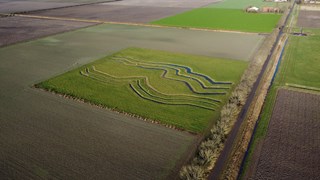A crazy art project or the Dutch Nazca lines?
What do we see here, a crazy art project or the Dutch Nazca lines?
No, it is not a art project, but a test field with ditch infiltration to keep archeology in the subsoil wet. The shape of the ditches is not motivated by human creativity, but by what can be found in the subsoil. Near the old island of Schokland in the North East Polder, there was an area with river dunes where people lived with their tools, partly of wood in prehistory. With the time and changes in the landscape, the dunes are buried in peat, and then overlaid by a layer of clay. But appearances are deceptive, the top of the dune is still near the surface.
As a result, archeology along the flanks of the dune is also hazard to be broken down by bacteria and fungi in the soil once oxygen is present. To protect this archeology, we do a test with ditch infiltration. The ditches are exactly along the flanks above the zones where archeology is vulnerable.
To test the effectiveness of this method of watering, we measure parameters in the soil, such as the soil moisture and oxygen content. In the attached graph (in Dutch), for example, the oxygen occurrence can be seen in the soil between the ditches. The concentrations at this measuring point drop as soon as the ditches are full of water and therefore the soil remains moist.
For more information you can contact our colleague Frouke Hoogland (mailto:frouke.hoogland@acaciawater.com)
 Greppels_2
Greppels_2
 Greppels_1
Greppels_1
 grafiek_greppelinfiltratie
grafiek_greppelinfiltratie